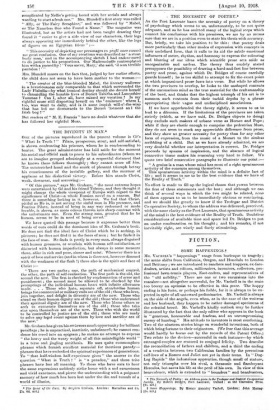THE DIVINITY IN MAN.*
ONE of the pictures reproduced in the present volume is Ge's "What Is Truth ? " Pilate, prosperous, stout, and self-satisfied, is shown confronting his prisoner, whom he is condescending to banter. The great administrator has laid aside for the moment his social and official rank to prove to his subordinates (whom we are to imagine grouped admiringly at a respectful distance) that he knows these fellows thoroughly ; they cannot score off him. The outstretched hand and the smirk of pleasant triumph betray his consciousness of the invisible gallery, and the murmur of applause at his dialectical victory. Before him stands Christ, weak, downcast, and sorrowing :— " Of this picture," says Mr. Graham, "the most extreme hopes were entertained by Ge and his friend Tolstoy, and they thought it might change the whole viewpoint of Europe with regard to the significance of Christ—a whole Russian novel on a canvas. But there is something lacking in it, however. We feel that Christ, pitiful as He is, is not saving the sinful man in His presence, and Pontius Pilate, instead of being in any way redeemed or made lovable, is shown as more odious thrown into sharp contrast with the unfortunate one. Even the strong man, granted that he be human, seems to be in need of being saved.'
We have quoted this passage because it expresses better than words of ours could do the dominant idea of Mr. Graham's book. He does not find the ideal face of Christ which he is seeking, in pictures ; he does not find it in the faces of men ; but he finds it in the face of man. He finds it partly in every man, always disguised with human grossness, or overlain with human self-satisfaction, or distorted with human imperfection, but always in some measure there, alike in rich and poor, sinner and saint. Wherever there is a spirit of love and service (and in whom is there not, however dimmed with the weakness of the flesh ?) there also is the spirit and face of Christ :— " There are two paths ; one, the path of mechanical control, the other, the path of self-realisation. The first path is the old, the second the new. The first is checked by condemnation of error and punishment ; the second must be allowed to be checked by the promptings of the individual human heart with infinite allowance made. . . . Those who hate, separate off, standardise human beings for commercial or military ends are of the old ; those who love, join together, and delight in diversity are of the new. Those who stand on their human dignity are of the old ; those who understand their spiritual dignity are of the new. Those who blame others or seek to exonerate themselves are of the old ; those who take sins upon themselves are of the new. Those who wish the world to be controlled by justice are of the old ; those who are ready to solve any legal count against them by love and sacrifice are of the new."
Mr. Graham has given his reviewers much opportunity for brilliant persiflage ; he is unpractical, inartistic, unbalanced; he cannot con- dense his creed into an epigram ; he makes no attempt to express "the heavy and the weary weight of all this unintelligible world" in a terse and jingling antithesis. He uses quite commonplace phrases which furnish excellent material for facetious parody— phrases that have embodied the spiritual experiences of generations. To "that half-wisdom half-experience gives" the answer to the question "What is Truth ? " is "a paradox," and these trite phrases have lost all meaning. To those who have ears to hear the same expressions suddenly strike home with a sad earnestness and vivid exactness, and pierce the understanding with a poignant memory of how much has been lost under the din and tumult of a world of illusior.„ • • The Quest of the Face. By bteplen Graham. London: Macmillan and Co. rs„ Gd, nct.1


































 Previous page
Previous page